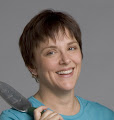
 Photos © Alan & Linda Detrick, Ellen Spector Platt Design
Photos © Alan & Linda Detrick, Ellen Spector Platt Designclick on photos to enlarge
While gardeners all over the country are scrambling to prepare new style Victory Gardens this spring, New York City gardeners with limited space ponder our choices. We can join a community garden, transform backyard flowerbeds into vegetable production, dig up front lawns and convert them to food production, or devote containers to vegetables.
When space is especially tight we can grow fresh herbs, making a huge impact on cooking and diet. Sprinkled on the most mundane dish, fresh herbs provide a flavor explosion. You don’t need armloads to transform a dinner; two or three sprigs are enough to make a huge difference in very simple meals.
Pinch an Inch
Each year I plant 6-8 containers of herbs on my rooftop garden so anyone in my building can ‘Pinch-an-Inch’. Most popular are the perennials; thyme, chives, sage, tarragon, oregano and mint (the kids pick it for ‘chewing gum’); and the annuals; basil, dill, and cilantro. Parsley is a biennial and slow growing, so I buy plants. Rosemary is tender but sometimes winters over. Dill, cilantro, borage and fennel may reseed themselves. Others of my personal favs are lemon verbena, lavender, and lemon scented geranium, all perfect for flavoring or decorating desserts.
 Herbs for Shade
Herbs for ShadeAll of the above prefer full sun and good drainage but if you have only part sun or part shade try chervil, lemon balm, cardamom (use the seeds), chives and horseradish, plus catmint (Nepeta cataria) for your tabby. What's your favorite for shady spots?
Seeds? Plants?
Begin your herb garden with either seeds or plants. Start perennial herb seeds on a sunny windowsill indoors in the beginning of March. Follow package directions and you’ll have small plants by June or July that will grow and last for years. Start annuals indoors as well, about April 1, or buy plants at green markets when all danger of frost has passed, around May 15. Basil is particularly sensitive to cold, so don’t rush it. I planted chive seed last March in the long box below . They and the other herbs were waiting their turn to go outside.
 A Good Read
A Good ReadHerb expert and teacher extraordinaire Betsy Williams just published a small, good-humored book, ‘Mrs. Thrift Cooks’ which is packed with dozens of recipes and tips on using fresh herbs, all with and eye to both taste and saving money. Mrs. Thrift is as good as her word; the book sells for just $6.95 at Betsy Williams.com.







5 comments:
I like to hide herbs in planters and flower boxes. Not only do I have color but I get the added benefit of being able to cook with them during the summer and harvest later in the fall when I take the planters apart.
I love your site and have been telling everyone about it. Thanks also as it makes me feel better about spring coming soon.
Bonnie
Flower show
where in nyc would you recommend buying herb seeds or actual herb plants?
thanks,
jon
Jon, My favorite place to buy herb plants is the Union Sq. Green Market on 14th St. Several vendors offer good selections of healthy plants. I buy from catalogs if I want a more specialized inventory. Well-Sweep Herb Farm in NJ offers over 60 lavender varieties and a similar selection of other herbs: www.wellspweep.com.
I usually order seeds on line from reneesgardenseeds.com or johnnyseeds.com.
Dear readers, what's your fav?
What soil do you use in the planters for herbs?
Do you feed during the growing season?
CGK,I usually plant in any soiless mix I get my hands on. I top dress with compost in spring, made by my red wiggler indoor worms, or my rooftop composter. If I run out, I buy compost bagged. I keep feeding my roses and tomatoes throughout the summer, but not my herbs.ESP
Post a Comment